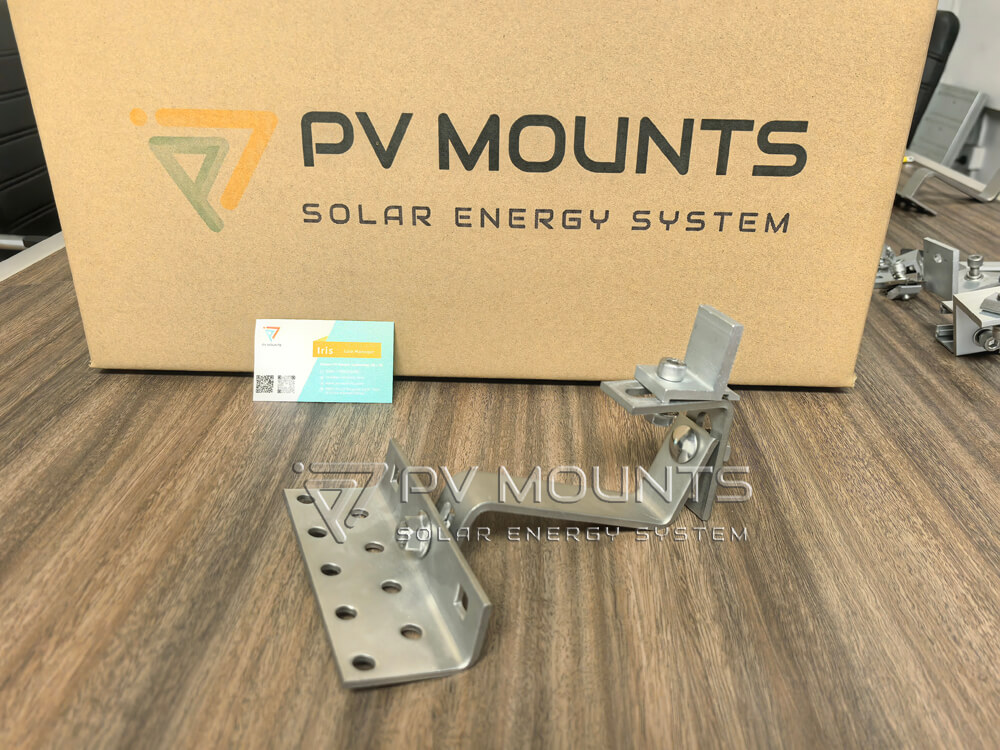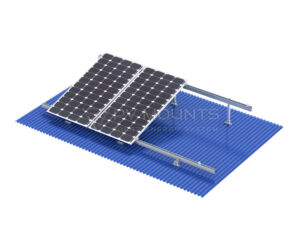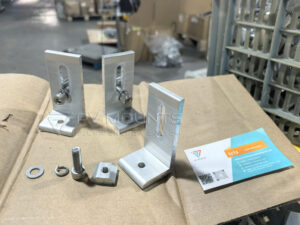Índice
1. Introduction: Why Tile Roof Hooks Are Critical for Solar Installations
Tile roofs are harder to work with than metal or flat roofs. Tiles come in many shapes and sizes, and they canbreak easily. Standard hooks often don’t fit well, leading to broken tiles, water leaks, and loose panels.
Mounting structure plays a key role in making sure the system lasts long and works well in any solar PV system. Roof hooks are a main part of this structure, especially for home tile roofs. They connect the mounting rails to the roof without damaging the tiles.
This is why customized solar tile roof hook solutions are important. These hooks are made to match specific tile types and roof structures. They help installers work faster, avoid damage, and make the whole system safer and more reliable.
Due to increasing renewable energy demand, especially in residential markets, ensuring the longevity and safety of solar arrays on tiled roofs is important. Let’s dive into why choosing the right customized solar tile roof hook solution can make or break your PV project.
2. Customized Solar Tile Roof Hook Solutions
Customized solar tile roof hook solutions are specially engineered components designed to fit unique tile profiles. These aren’t off-the-shelf items; they’re the result of precise measurements, material selection, and collaborative product development between solar installers and hardware manufacturers.
A truly customized solution addresses:
- Tile compatibility: Roman, Spanish, flat, or interlocking tiles all require different hook geometries.
- Roof pitch and truss alignment: Hooks must adapt to various substructures for effective load transfer.
- Weather conditions: Coastal regions need corrosion-resistant materials, while snow-prone areas demand extra strength.
- Ease of installation: Pre-assembled or adjustable hooks reduce onsite labor and installation time.
When installers choose customization, they get a product that’s tested for durability, optimized for local building codes, and streamlined for repeat projects.
3. Types of Solar Tile Roofs
There’s no one-size-fits-all in tile roofing, which is why understanding tile types is key to hook design.
| Tile Type | Characteristics | Mounting Challenges |
|---|---|---|
| Clay Tiles | Fragile, traditional, curved | Prone to cracking, difficult to cut |
| Concrete Tiles | Heavier, durable | Require height-adjustable hooks |
| Flat Tiles | Clean look, smooth surface | May need elevated hooks |
| Interlocking Tiles | Weatherproof overlap design | Limited space for anchor penetration |
Each roof type impacts hook positioning, bracket thickness, and waterproofing approach. Therefore, before placing an order, it’s best to request samples or perform an onsite assessment.
4. Material & Design Considerations
Customized hooks must strike the right balance between strength, flexibility, and longevity. The two most common materials used are:
- Stainless Steel (SUS 304/316) – Preferred option
- Excellent corrosion resistance
- High load-bearing strength
- Ideal for coastal or humid environments
- Aluminum Alloys (6005-T5)
- Lightweight and easy to handle
- Corrosion-resistant with anodized finish
- Suitable for cost-sensitive markets
Design features to look for include:
- Multi-hole base plates for better positioning
- Adjustable height brackets
- Pre-integrated EPDM pads for waterproofing
- Locking grooves to prevent tile slippage
The right material and design can extend the life of the solar system by years.
5. Installation Techniques & Best Practices
Proper installation ensures performance, aesthetics, and warranty compliance. Here’s a simplified guide:
- Tile Removal: Remove the tile where the hook will be placed.
- Hook Fixing: Attach the hook to the rafter using stainless screws.
- Tile Cutting (if needed): Use a grinder to notch the tile for hook clearance.
- Tile Reinstallation: Place the tile back ensuring no gaps or raised sections.
- Rail Attachment: Mount the rail using T-bolts and tighten firmly.

Pro Tips:
- Always use waterproofing membranes or flashing around penetrations.
- Avoid over-torquing screws to prevent wood splitting.
- Confirm truss positions before drilling.
These practices not only improve installation speed but protect against future maintenance issues.
6. OEM & ODM Customization Benefits
OEM and ODM services add even more value. With OEM, your logo and brand can be added to the product and packaging. With ODM, you get new designs based on your needs — like special shapes, stronger materials, or smart ways to save time during installation.
If you’re an EPC company or distributor, opting for OEM/ODM customization brings a range of benefits:
OEM (Original Equipment Manufacturer):
- Branding opportunity (logo engraving)
- Control over packaging, labeling, and documentation
ODM (Original Design Manufacturer):
- Custom hook shape, dimension, and rail compatibility
- Technical consultation for new tile types
- Prototyping support
Partnering with a manufacturer like Xiamen PV Mounts gives you access to engineering support, digital modeling, and consistent QC. This creates a more professional image for your brand while improving client satisfaction
7.Comparison: Standard vs. Customized Tile Roof Hooks
Standard roof hooks may seem cost-effective, but they often bring limitations, especially on tile roofs. They are typically designed for general use, which means they may not align well with all tile profiles. This can result in broken tiles, longer installation times, and increased service calls.
Customized tile roof hooks, on the other hand, are tailored for specific tile types and project needs. They improve fit, reduce the need for tile cutting, and make installation smoother and faster.
| Feature | Standard Hook | Customized Hook |
| Tile Compatibility | Low | High |
| Installation Time | Longer | Faster |
| Risk of Tile Damage | High | Low |
| Waterproofing | Often Requires Extra Steps | Integrated or Optimized |
| Appearance | May be Visible | Flush or Hidden |
| Cost Efficiency (Long Term) | Lower | Higher |
Example Case:
- In a rooftop project using standard hooks on interlocking clay tiles, installers had to manually cut over 200 tiles, leading to cracks and delays.
- A similar project using customized hooks completed 25% faster with zero tile damage.
Customized solutions not only save time and labor, but they also help preserve roof integrity, reduce callbacks, and enhance system durability.
8. Cost vs. Performance Analysis
While standard hooks are cheaper upfront, they often result in:
- Higher labor costs
- Roof tile damage
- Water leakage risks
Customized solutions, although slightly more expensive, bring value through:
- Reduced installation time
- Lower service call rates
- Enhanced structural safety
| Factor | Standard Hook | Customized Hook |
| Initial Cost | $ | $$ |
| Installation Time | Longer | Shorter |
| Roof Compatibility | Limited | High |
| Maintenance | Frequent | Rare |
| Warranty Risk | High | Low |
In long-term projects, customized tile roof hooks deliver higher ROI and client satisfaction.
9. Application Scenarios: Tile Roof Hook in Global Solar Projects
Europe (Germany, Spain, Italy): Tile roofs are common in many parts of Europe, especially in countries like Germany, Spain, and Italy. These markets often feature Roman or flat clay tiles, which require precise, non-invasive mounting methods. Customized hooks allow installers to avoid damaging traditional roof tiles and comply with local building codes, which are often strict.
Southeast Asia & Latin America: In tropical regions such as Thailand, the Philippines, and parts of Central and South America, solar adoption is rising fast. These areas often use thick, overlapping tiles made from concrete or clay. Due to frequent rainfall and high humidity, corrosion-resistant hooks—especially those with waterproof designs—are in high demand. Custom hooks reduce installation times and improve overall system stability in areas where skilled labor may be limited.
These application scenarios show how customized hooks are essential in varied global markets, not only for functional fit but also for compliance, safety, and efficiency.
Here are some cases for reference,
Germany: A 500kW residential project in Bavaria used PV Mounts’ custom hooks for flat concrete tiles. The result? 20% faster installation and zero tile breakage.
Thailand: A coastal resort needed anti-corrosive hardware. Stainless steel 316L hooks provided unmatched longevity against salt exposure.
Spain: Roman clay tile roofs required special curved hooks. The project achieved seamless integration with no visible mounting parts.
These real-world examples show that customized solar tile roof hook solutions are more than a product—they’re a project enabler.
10. Common Mistakes to Avoid
- Using the wrong hook profile: Leads to cracked tiles or floating modules.
- Ignoring roof substructure: Weak rafters can’t hold the weight.
- Skipping flashing or waterproofing: Causes long-term damage.
- No pilot holes: Results in split timber.
- Over-tightening screws: Deforms hooks or breaks tiles.
Installers must always follow the manufacturer’s guide and consult before adapting products onsite.
11. FAQs About Customized Solar Tile Roof Hook Solutions
Q1: Do I need a custom tile roof hook for my solar project?
Yes. If you’re working with clay, concrete, or interlocking tiles, a custom hook ensures a better fit and reduces the risk of tile breakage or water leakage.
Q2: Can customized tile hooks be reused?
Most stainless steel or aluminum custom hooks can be reused if removed carefully. Always inspect them for wear or deformation before reuse.
Q3: Are they compatible with micro inverters or optimizers?
Yes. Most customized hooks are designed to fit common rail systems that support micro inverters and power optimizers.
Q4: How do I know which hook fits my roof tiles?
Provide tile samples, measurements, or technical drawings. Reputable suppliers can recommend or design a hook that matches your roof’s profile.
Q5: What’s the MOQ for OEM customization?
It typically starts at 500–1,000 units, but some manufacturers may accommodate lower volumes for simpler or repeat designs.
Q6: Can custom hooks be used on slate roofs?
Yes, but slate is very fragile. Only use slate-compatible hooks specifically designed for that tile type.
Q7: Is sealant required under the hook?
If flashing is used properly, sealant is optional, though it can add extra protection.
Q8: How do I know the hook is strong enough for harsh weather?
Manufacturers can provide static load test reports.
Q9: Can I get CAD files or technical drawings?
Yes. Most suppliers offer 2D/3D files to help with project design and installation planning. Welcome you to provide your own 3d file to get customized tile roof hook quotation.
12. PV Mounts: Your Trusted Supplier for Customized Tile Roof Hooks
PV Mounts specializes in high-quality, customized solar tile roof hook solutions. With a focus on engineering precision and customer success, we support EPCs, installers, and distributors worldwide.
What We Offer:
- Fast Prototyping: From CAD drawings to real samples, we can deliver prototypes in as little as 5–7 days.
- Stable Supply Chain: With large in-house inventory and streamlined production, we ensure fast delivery even for bulk orders.
- Certified Products: Our hooks are CE certified, meeting international standards for quality and safety. SGS test report is available.
Client Success Stories:
- A German EPC firm reduced installation time by 30% using our hooks tailored for flat clay tiles.
- In Brazil, our anti-corrosion stainless steel hooks supported over 2 MW of rooftop systems in coastal towns.
We pride ourselves on our responsive service, technical expertise, and flexible OEM/ODM programs. Whether you need a unique design, brand labeling, or engineering support, PV Mounts is your ideal partner for tile roof solar mounting solutions.
13. Conclusion: Invest in Smart Customization for Lasting Results
Customized solar tile roof hook solutions offer clear advantages in performance, durability, and ease of installation. By matching the exact needs of each roof type and climate, these hooks help ensure long-term system reliability and lower maintenance risks. Whether it’s preventing cracked tiles, enhancing waterproofing, or speeding up installation, the benefits of customization are tangible across global markets.
As solar adoption continues to grow, particularly in complex residential or retrofit environments, the need for tailored mounting hardware becomes critical. Choosing smart, project-specific components can make a measurable difference in quality, customer satisfaction, and ROI.
In short, choosing the right customized tile hook protects the roof, improves performance, and ensures the solar panels last for many years.
📩 Ready to upgrade your mounting solution?
Contact PV Mounts today for custom design consultations, quick prototyping, and global delivery support. Let’s power your solar project — the right way, from the roof up.
Whether you’re exploring your first order or scaling a mature brand, our team can help you:
- Optimize your solar tile roof hook supply chain
- Develop unique solar tile roof hook
- Manage low-risk MOQs with full OEM/ODM support
- Access sample kits with real-time logistics

📩 Email to info@pv-mounts.com or message on WhatsApp: +86-178 5013 2473
📦 Ask about our latest solar tile roof hook catalogue y free sample
Reference inbound Links:
Reference Outbound Links:













